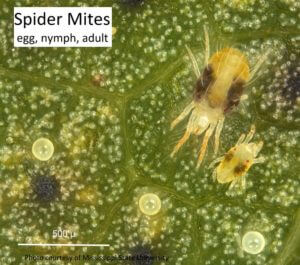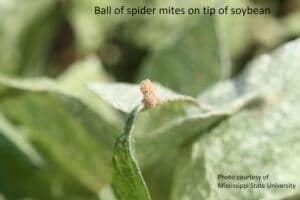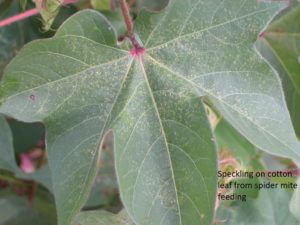 Spider mites are an occasional pest of soybeans. They are not insects, being more closely related to spiders. The twospotted spider mite is the most common mite found infesting soybeans. At full size, spider mites are only 0.3-0.4 mm long and difficult to see with the naked eye. They are pale-yellow to orange in color, and under magnification, a dark spot can be seen on either side of the body. Sometimes, a dark red body color is observed (previously called the carmine mite). The adult and nymphal stages have eight legs, but the larval stage that emerges from the egg has six legs. Both immature and adult spider mites cause injury to soybeans by sucking juices from plants. As their name suggests, a fine silken webbing is produced by the mites and may be observed on infested leaves. They may feed on all plant structures but are most commonly observed on the undersides of leaves. Infestations are often most severe during hot and dry weather. Mites reduce the plant’s ability to produce photosynthate, and under severe infestations, cause premature defoliation.
Spider mites are an occasional pest of soybeans. They are not insects, being more closely related to spiders. The twospotted spider mite is the most common mite found infesting soybeans. At full size, spider mites are only 0.3-0.4 mm long and difficult to see with the naked eye. They are pale-yellow to orange in color, and under magnification, a dark spot can be seen on either side of the body. Sometimes, a dark red body color is observed (previously called the carmine mite). The adult and nymphal stages have eight legs, but the larval stage that emerges from the egg has six legs. Both immature and adult spider mites cause injury to soybeans by sucking juices from plants. As their name suggests, a fine silken webbing is produced by the mites and may be observed on infested leaves. They may feed on all plant structures but are most commonly observed on the undersides of leaves. Infestations are often most severe during hot and dry weather. Mites reduce the plant’s ability to produce photosynthate, and under severe infestations, cause premature defoliation.
Sampling for mites is based on visual observations of injury symptoms, such as leaf speckling and premature yellowing of leaves, or by seeing mites on the undersides of leaves.
Thresholds for spider mites are not well established in soybean. Consider treatment when spider mites are present on the majority of plants and premature defoliation is occurring.
Management options
| Insecticide (Trade Names) for SPIDER MITES | Lb Active Ingredient per Acre | Amount Formulation per Acre | Performance Rating |
| abamectin (Agri-Mek SC 0.7) | 0.01 - 0.019 | 1.75 - 3.5 oz | 8 |
| bifenthrin (Brigade 2E, Discipline 2E, Fanfare 2E) * | 0.063 - 0.10 | 4 - 6.4 oz | 6 |
| dimethoate 4 * | 0.5 | 16 oz | 4 |
| etoxazole (Zeal SC 2.88, Stifle SC 2.88) | 0.045 - 0.135 | 2 - 6 oz | 8 |
* These products may only provide suppression of spider mites.
- Avoid unnecessary insecticide applications that kill beneficial insects and may cause outbreaks of spider mites.
- Well-watered or irrigated soybean are less likely to be heavily infested or benefit from treatment.


